Specifications of Leopard netting
| Item ID | Leopard Netting Specifications | Material |
|---|---|---|
| HM2438 | 1.5″ x 1.5″ x 3/32″ | SS304/316 |
| HM2450 | 2″ x 2″ x 3/32″ | SS304/316 |
| HM2476 | 3″ x 3″ x 3/32″ | SS304/316 |
| HM24102 | 4″ x 4″ x 3/32″ | SS304/316 |
| HM3250 | 2″ x 2″ x 1/8″ | SS304/316 |
| HM3276 | 3″ x 3″ x 1/8″ | SS304/316 |
| HM32102 | 4″ x 4″ x 1/8″ | SS304/316 |
Understanding Leopard Netting
Leopard netting is a specialized form of enclosures designed to ensure the safety and security of leopards while enhancing their living environment. Unlike traditional fencing, which typically employs solid barriers, leopard netting utilizes a unique mesh structure that allows for better visibility and interaction between the animals and their habitats. This type of netting serves a dual purpose: it not only prevents the escape of the leopards but also protects them from external threats, such as other animals or human interference.
One of the most significant features of leopard netting is its distinctive rhombus mesh design, which provides superior strength and durability compared to standard fence materials. This specific shape is not only visually appealing but also ensures that the leopards cannot easily claw or bite through the netting, thereby reducing the risk of injury or escape. The hand-woven technique used in the construction of leopard netting further enhances its resilience and flexibility. Such craftsmanship ensures that each unit of netting is tailored to withstand various environmental factors, making it suitable for different climates and conditions.
Quality materials are paramount in the production of leopard netting. A well-constructed netting system utilizes high-grade, weather-resistant materials that can endure exposure to the elements. This is crucial for maintaining the integrity of the enclosure over time. Cheap or inferior materials can fail and compromise the safety of the leopards, which is why it is essential to invest in premium netting that supports animal welfare standards. Overall, understanding the unique attributes of leopard netting and its importance in creating secure enclosures will enable caretakers to make informed decisions when selecting fencing solutions for leopard habitats.
Key Features of High-Quality Leopard Netting
When selecting the appropriate netting for leopard enclosures, it is crucial to consider the key features that define high-quality leopard netting. First and foremost, the material used plays a vital role in determining the effectiveness and longevity of the fencing solution. High-quality leopard netting is typically constructed from stainless steel wire rope, which offers exceptional strength and rust resistance, ensuring the enclosure remains intact and secure for years. Unlike traditional fencing materials, stainless steel provides a robust barrier capable of withstanding the inherent strength and agility of leopards.
Another significant characteristic of leopard netting is its virtual indestructibility. The design and manufacturing processes result in a product that exhibits remarkable impact resistance, effectively protecting both the leopards and their enclosures from external threats. The break resistance of this type of fencing is particularly critical, as it must endure the constant pressures exerted by the animals itself. This durability minimizes the likelihood of damage and subsequent repairs, ultimately reducing maintenance costs associated with the enclosures.
Besides strength, flexibility is a key attribute of high-quality leopard netting. A flexible netting solution can adapt to the natural movements and behaviors of leopards, allowing for a comfortable and safe habitat. This adaptability reduces stress for the animals, as they are less likely to feel confined in an overly rigid structure. Furthermore, a flexible design enables easy installation and adjustments, making it more user-friendly for caretakers. Overall, choosing premium leopard netting ensures that the enclosure provides a safe, durable, and adaptable environment tailored to the specific needs of leopards, safeguarding their well-being and enhancing their quality of life.
Weather Resistance and Longevity of Leopard Netting
When selecting netting for leopard enclosures, it is imperative to consider its weather-resistant properties, as these greatly affect both functionality and durability. Leopard netting is specifically designed to withstand various weather conditions, from heavy rain and snow to the fierce winds associated with hurricanes. This resilience ensures that the enclosure remains intact and secure, safeguarding the animals inside against external threats such as harsh weather or potential escapes.
One of the standout features of leopard netting is its exceptional UV resistance. Prolonged exposure to sunlight can degrade many materials; however, quality leopard netting incorporates advanced UV protective elements that prevent deterioration over time. This protection not only extends the life of the netting but also minimizes the need for frequent replacements, making it a cost-effective option in the long run.
Leopard netting is designed to maintain its integrity for over 30 years, even in diverse climates and environments. This longevity allows for its use in various habitats, whether in regions prone to extreme temperatures, incessant rainfall, or long periods of sunlight. The durability of leopard netting means that caretakers can focus on the health and well-being of the leopards rather than the maintenance of the fencing.
Ultimately, the weather resistance and longevity of leopard netting play critical roles in protecting these magnificent animals. Selecting netting that can endure severe weather conditions not only enhances safety and security but also supports the long-term welfare of leopards in captivity. The investment in high-quality, weather-resistant netting will ensure that enclosures remain functional and effective throughout the years, providing peace of mind to caretakers and ensuring the animals remain safe from environmental challenges.
Installation and Maintenance of Leopard Netting
When installing leopard netting for enclosures, careful planning and execution are essential to ensure the safety and comfort of the leopards. The first step involves determining the layout of the fencing. It is crucial to assess the area where the netting will be installed, considering factors such as the terrain, the size of the enclosure, and the natural behavior of leopards. Identifying these factors helps in determining the appropriate height and size of the netting required, as well as its distance from any vertical structures that could provide a climbing advantage for the leopards.
For the installation process, specific equipment is necessary to ensure that the leopard netting is securely affixed. This may include tensioning hardware, anchors, and support posts, which should be made from durable materials resistant to weather conditions and animal interference. It is advisable to use heavy-duty stakes or concrete footings for vertical supports to prevent sagging or collapse of the netting structure. The netting should be tautly secured to avoid any gaps that could pose risks to the leopards or allow escape.
Maintenance of leopard netting is equally important for long-term functionality. Regular inspections should be conducted to check for signs of wear and tear, such as fraying or holes. Any damaged sections should be promptly repaired to maintain the integrity of the enclosure. Weather conditions can also impact the durability of the netting; therefore, seasonal maintenance should entail cleaning debris that may accumulate at the base and ensuring that the support structures remain stable. By following these installation and maintenance practices, keepers can uphold the efficacy of leopard netting while providing a secure habitat for the animals.
Why Choose Hand-Woven Leopard Netting?
When selecting fencing solutions for leopard enclosures, hand-woven leopard netting stands out for its numerous advantages over machine-produced alternatives. One of the most significant benefits is the level of craftsmanship involved in hand-weaving. Artisans dedicate time and effort to each piece of netting, ensuring high-quality construction that is tailored to meet specific needs. Unlike machine-produced netting, which may lack consistency and durability, hand-woven options tend to exhibit superior quality, reinforcing their relevance in safeguarding animal habitats.
Reliability is another critical factor in the choice of hand-woven leopard netting. The artisanal construction practices used in hand-weaving often incorporate traditional techniques that have been honed over time. This method not only enhances the durability of the netting but also improves its ability to withstand the challenging conditions often present in leopard habitats. The flexibility of these materials is essential, as it allows for adaptations in various environmental settings, promoting better integration into the natural landscape.
There are common misconceptions regarding the efficacy of hand-woven netting. Some may assume that machine-produced netting is sufficient due to its lower cost and faster production time. However, this perception often overlooks the long-term benefits associated with investing in high-quality, hand-woven options. By opting for such netting, enclosure designers can avoid the potential pitfalls of lower-grade materials, such as frequent replacements and inadequate animal protection. Investing in hand-woven leopard netting ultimately translates to better welfare for the animals and enhanced safety of the enclosure.
In conclusion, hand-woven leopard netting represents a reliable and effective choice for creating secure habitats for leopards. Its artisan craftsmanship, durability, flexibility, and long-term value make it the preferred option for ensuring animal safety and enclosure security.
Various solutions for leopard fence & netting
The following are the common protection schemes and specifications for leopard fences.
Zoo enclosures for Leopard exhibits
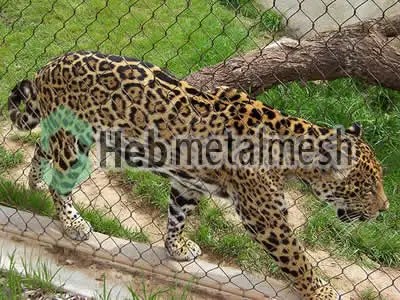
Recommended specifications:
Handwoven stainless steel netting HM3276;
Stainless steel wire rope: 1/8″ (3.18 mm);
Mesh opening size: 3″ x 3″ (76 mm x 76 mm);
See Details: Handwoven stainless steel netting HM3276
Wire mesh for Leopard enclosures
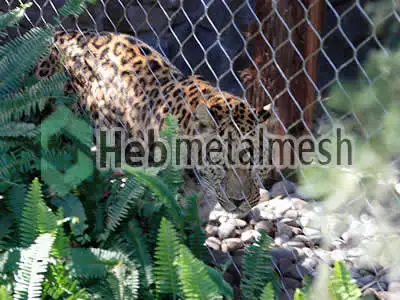
Recommended specifications:
Handwoven stainless steel netting HM3276;
Stainless steel wire rope: 1/8″ (3.18 mm);
Mesh opening size: 3″ x 3″ (76 mm x 76 mm);
See Details: Handwoven stainless steel netting HM3276
Wire mesh for Leopard control
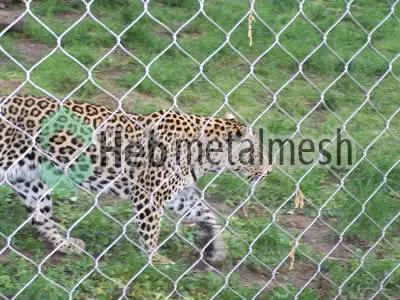
Recommended specifications:
Handwoven stainless steel netting HM2450;
Stainless steel wire rope: 3/32″ (2.38 mm);
Mesh opening size: 2″ x 2″ (51 mm x 51 mm);
See Details: Handwoven stainless steel netting HM2450
Zoo mesh for leopard enclosures
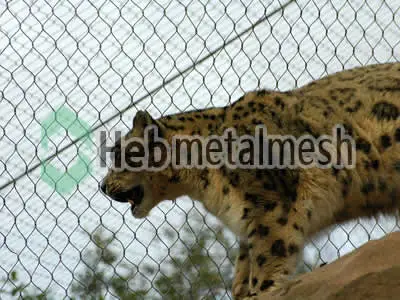
Recommended specifications:
Handwoven stainless steel netting HM2450;
Stainless steel wire rope: 3/32″ (2.38 mm);
Mesh opening size: 2″ x 2″ (51 mm x 51 mm);
See Details: Handwoven stainless steel netting HM2450
Leopard zoo enclosure fencing
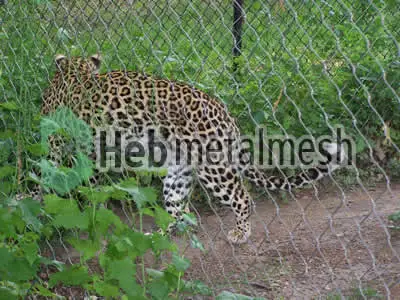
Recommended specifications:
Handwoven stainless steel netting HM3276;
Stainless steel wire rope: 1/8″ (3.18 mm);
Mesh opening size: 3″ x 3″ (76 mm x 76 mm);
See Details: Handwoven stainless steel netting HM3276
Leopard enclosure cover system
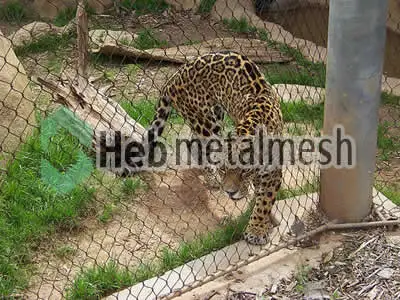
Recommended specifications:
Handwoven stainless steel netting HM3276;
Stainless steel wire rope: 1/8″ (3.18 mm);
Mesh opening size: 3″ x 3″ (76 mm x 76 mm);
See Details: Handwoven stainless steel netting HM3276
Leopard protection mesh system
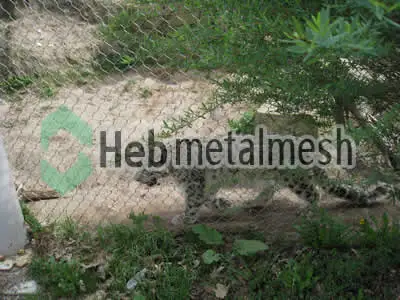
Recommended specifications:
Handwoven stainless steel netting HM3276;
Stainless steel wire rope: 1/8″ (3.18 mm);
Mesh opening size: 3″ x 3″ (76 mm x 76 mm);
See Details: Handwoven stainless steel netting HM3276
Leopard exhibit design
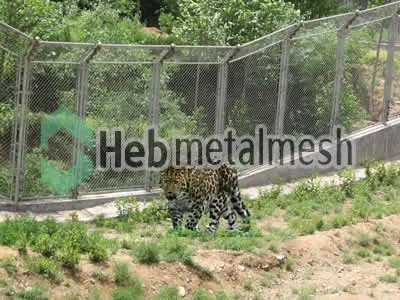
Recommended specifications:
Handwoven stainless steel netting HM2476;
Stainless steel wire rope: 3/32″ (2.38 mm);
Mesh opening size: 2″ x 2″ (51 mm x 51 mm);
See Details: Handwoven stainless steel netting HM2476
Stainless steel mesh for leopard exhibit, leopard enclosures, leopard cage
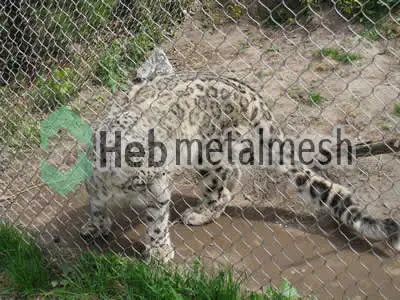
Recommended specifications:
Handwoven stainless steel netting HM3276;
Stainless steel wire rope: 1/8″ (3.18 mm);
Mesh opening size: 3″ x 3″ (76 mm x 76 mm);
See Details: Handwoven stainless steel netting HM3276
Stainless steel mesh for leopard protection netting, leopard barrier mesh
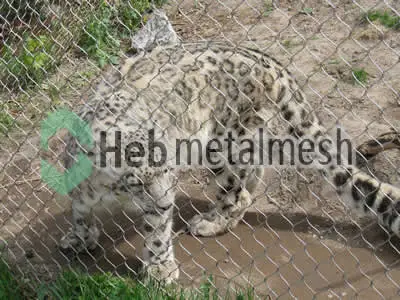
Recommended specifications:
Handwoven stainless steel netting HM3276;
Stainless steel wire rope: 1/8″ (3.18 mm);
Mesh opening size: 3″ x 3″ (76 mm x 76 mm);
See Details: Handwoven stainless steel netting HM3276
Factory supplies for leopard exhibit fencing mesh, leopard enclosures mesh
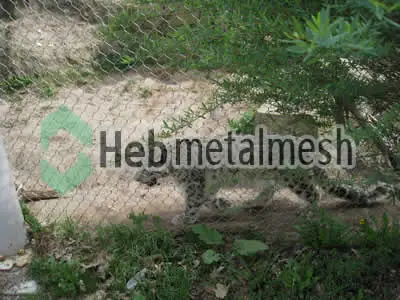
Recommended specifications:
Handwoven stainless steel netting HM3276;
Stainless steel wire rope: 1/8″ (3.18 mm);
Mesh opening size: 3″ x 3″ (76 mm x 76 mm);
See Details: Handwoven stainless steel netting HM3276
Stainless steel leopard roof netting,leopard perimeter mesh, leopard fencing
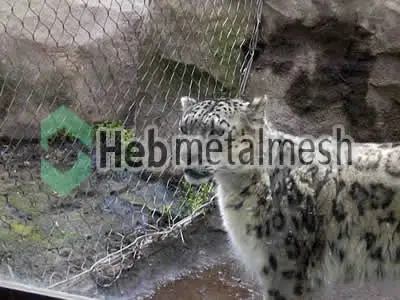
Recommended specifications:
Handwoven stainless steel netting HM3276;
Stainless steel wire rope: 1/8″ (3.18 mm);
Mesh opening size: 3″ x 3″ (76 mm x 76 mm);
See Details: Handwoven stainless steel netting HM3276
In general, the size of the mesh aperture depends on the size of the leopard. The diameter of the wire rope depends on the strength of the leopard. Specific specifications need to be selected according to the actual leopard breed and size.
In addition, we also have the following stainless steel rope mesh product specifications suitable for application for leopard fence mesh.